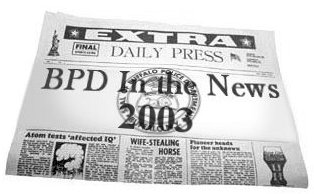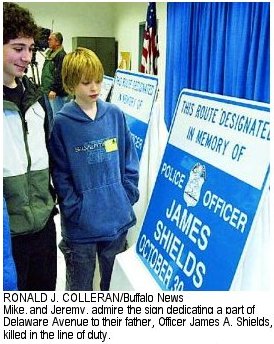|
City Police Go Solo
Reprint from Buffalo News 07-16-2003)
A lengthy era in Buffalo law enforcement will start to wind down today as
police begin the change-over to one-officer patrol cars
By GENE WARNER News Staff Reporter 7/16/2003
Some of them became best friends for life. Others became confidants and amateur psychologists for each other. Some
even wound up as husband and wife.
There are few professional bonds as strong as the one that binds Buffalo police partners, who ride 10-hour shifts
together, often depending on each other for their own safety - even for their lives. But a new era in Buffalo police annals
dawned at 6:15 a.m. today, when the first one-man car was scheduled to leave the Central District station house at Main
and Tupper streets.
One-officer patrol cars are being phased in throughout the city over the next six months, and the culture of city police
work never will be quite the same. "We've been preparing for one-officer cars for several years," Police Commissioner
Rocco J. Diina said Tuesday. "The majority of America now patrols like this." But the Buffalo Police Department isn't
just copying a national trend of one-officer patrol cars.
It's doing this to survive:
To survive, when it's cutting 30 percent of its manpower over a five-year period. To survive, when Erie County officials
are pushing a plan that essentially would have the Sheriff's Department swallow the Buffalo Police Department whole.
And to survive the potential loss of decision-making ability with the city's new financial control board peeking over the
shoulder of the Buffalo police brass.
Top police officials aren't ducking the issue. They know the department's survival is at stake. "We all need to make this
work, to be able to survive as a department," Chief of Staff James P. Giammaresi said Tuesday, during the final training
session for dispatchers and 911 officials.
"We have a control board coming in this afternoon," added Edward C.
Hempling, the department's chief of fiscal
operations. "We'd rather make the hard decisions ourselves, rather than have them make them for us." Contrary to what
many people seem to think, the conversion to one-officer patrol cars won't be restricted to certain parts of the city. Top
police officials realized it would be difficult to mix and match one-officer cars with two-officer cars in various parts of the
city.
The conversion begins today in the Central District, which covers downtown, the Lower West Side and the heart of the
city up to West Ferry Street and over to Jefferson Avenue. It then will move, in order, to the Northwest District, the
Northeast District, the Ferry-Fillmore District and finally the South District. Police officials hope to have the conversion
complete by the end of the year.
Camaraderie to change
No one can dispute that the move to one-officer cars will shatter the patrol-car camaraderie that has existed since Buffalo
replaced horse-and-buggies with police cars almost a century ago.Central District Officers Paul Hoppy and Lou Ruberto
have been riding together for 17 years. That ends today. "What you're going to miss is the extra set of eyes in the car, to
keep you out of accidents and other situations," Ruberto said. "Now it's going to be difficult to do everything by yourself."
"We even think alike," Hoppy added. "Being together so long we know what each other is thinking and what we're going
to do next. It's just worked real well."
Police Benevolent Association President Robert P. Meegan Jr. couldn't be reached directly in repeated attempts
Tuesday, but he did respond with a brief voice-mail comment, saying that the implementation of one-officer cars was one
of the terms of the new collective-bargaining agreement reached in March. "Obviously, the PBA's focus is on the
paramount safety of the police officers of the city of Buffalo during this conversion period," Meegan said.
One Central District officer, a 19-year veteran who wouldn't give his name, believes the one-officer cars will increase
police officers' risk by about 50 percent. "You're going to see more officers getting injured, and you may see an increase
in suspects getting injured, because you may have to take quick action to protect yourself," he said. "But it's 2003, and
it's here," he added. "The other departments seem to be going to it, and it seems to be successful." Greater alertness
expected Police officials believe officers will have to be more alert while riding alone.
"When you're with a partner, it seems as if half your attention is being paid to the other person," Giammaresi explained.
"You're talking about where you're going to go to eat or about each other's kids. It's a very social environment. This gives
us the ability to do more with less, because you're going to have to be more alert."
But there are negatives, too.
Partners often engaged in on-the-job training, discussed crime-fighting strategies with each other and lent each other an
ear to listen to job frustrations and anxieties. That two-person camaraderie will be hard to replace. Now, officers will
have to cover each other's back, providing quick backup, especially when a seemingly routine shoplifting or loud-music
call puts the first officer at the scene at risk. "Now you're going to have a whole platoon working as a team, instead of
having two officers working together," Giammaresi said. "I think the camaraderie for the whole platoon will improve."
Police officials aren't blind to the challenges they face.
Dispatchers will assign cars based on the type of call. For example, two cars and one lieutenant would respond to a
shooting, stabbing or kidnapping. Just one car would respond to a shoplifting or property dispute. Communication will be
key. A burglary-in-progress would bring two cars and one lieutenant; a burglary after the fact would require just one
patrol car.
"The biggest challenge is to make sure the communication works properly, that the right information gets out to the
officer," Giammaresi said. "And we want to make sure the John Waynes and Jane Waynes wait for their backup."
When should officers radio for backup help?
"Any time an officer has a gut feeling that something is wrong, we're telling them to call for backup," Officer Kimberly
Beaty said during training at the Police Academy on Tuesday. "Officer safety is our primary goal." No matter how much
they're trained, officers will have to develop their own new strategies.
"We understand that there's going to be a learning curve on the streets and a learning curve in dispatch," Inspector Joseph
F. Strano said. "We are aware that officers (at first) will be backing up each other to the extreme."
While some officers remain skeptical, the switch to one-officer cars will increase the typical number of cars on the street
at any one time from between 40 and 60 now to between 60 and 80, police officials estimate. "It's going to allow us to
provide better service to the citizens," Diina said. "People want to see police, and you're going to have a larger number of
cars out there on the street."
Number of officers to drop
The number of sworn officers in the Buffalo police ranks, 972 as of June 30 last year, has dropped to 865 today, with a
goal of reaching 675 four years from now. That's more than a 30 percent projected drop in five years. "That's a
substantial reduction," Hempling said. "We could not go down that far with two-officer cars, without substantial loss of
service and substantial overtime." Still, the jury remains out on how this all is going to work. "It's going to be different,"
Officer Hoppy said, preparing for his last ride Tuesday with his longtime partner. "It's going to be a big change for the
whole city. I hope it works out."
|

